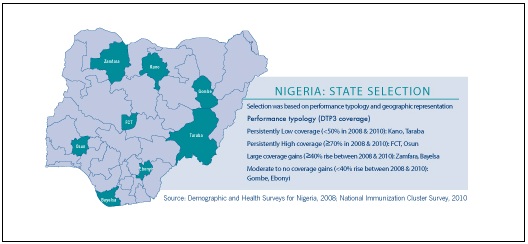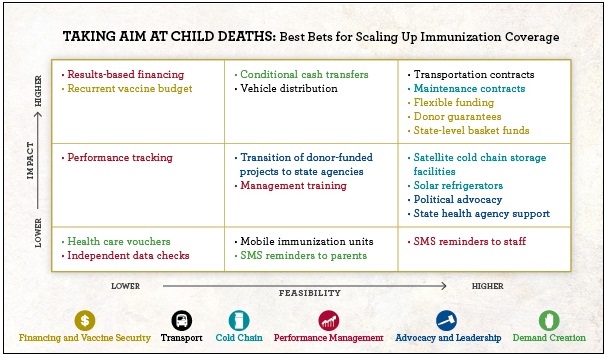
With nearly 160 million people and rich with oil and gas reserves, Nigeria has tremendous human and natural resources to bring to bear on its challenges. This week, Nigeria's leaders will be focused on adding political will to the resources they bring to bear for the sake of children during a Nigerian Vaccine Summit.
This is an exciting time for a vaccine summit in Nigeria, where there is both much to be done and much to work with. With the world's second largest number of child deaths each year, many of which are due to diseases that could be prevented with vaccines, yet with immunization coverage rates that are lower than many other countries in the region, Nigeria has a major opportunity to save lives by raising immunization coverage and introducing new vaccines against pneumonia and diarrhea, the leading killers of children worldwide.
Nigeria has taken many important steps in recent years to address immunization and child mortality, to be sure. Between 2000 and 2010, the country increased coverage rates with childhood vaccines for polio, diphtheria, pertussis and tetanus; last December they conducted mass vaccinations with a new meningitis A vaccine developed specifically for preventing meningitis epidemics in sub-Saharan African populations, and they are on target to introduce the latest-generation pentavalent vaccine, which protects against five childhood diseases including Hib pneumonia and meningitis, next month. Likewise, as one of only three remaining countries in the world with endemic polio transmission, they have recently ramped up efforts to eradicate polio from the country, and thereby, help rid it from the entire world.

But more remains to be done as well. While the country has expressed an interest to the GAVI Alliance in introducing the new pneumococcal pneumonia and rotavirus diarrhea vaccines to the national program, this has not yet happened. And once introduced, many obstacles remain in actually delivering those vaccines, especially the millions of children living in Nigeria's poorest and most rural areas.
That's why this week IVAC issued the report of a study that identifies the six main barriers keeping vaccines from reaching Nigerian children and recommends packages of solutions tailored to overcoming them. As our Landscape Analysis of Routine Immunization in Nigeria (LARI) shows, these barriers can be overcome with dedicated funding, coordinated effort and importantly, political will.
Here's what our report found:
1. Financing: In Nigeria, vaccines are funded as one-time expenses, like the building of a bridge. But vaccines aren't one-time expenses -- they require a regular stream of funding because new "customers" are born every day. Stock outs were identified as a problem that can potentially be avoided by simply assuring the timely and consistent release of funds throughout the year, rather than the delayed release of funds late in the year. Possible solutions include funding vaccine procurement as a recurrent rather than a capital expense, or creating donor-backed revolving funds or financial guarantees to avoid supply interruption when federal funds are delayed.
2.Transport: A reliable transport system with properly maintained vehicles is vital to ensuring that rural communities don't get cut off from the vaccines they need. All too often in Nigeria, it's an unreliable transport system with poorly maintained vehicles that stands in the way of a mother vaccinating her child. A package of solutions including contracts between the government and local vendors to maintain fleets could help to solve this problem.
3.Temperature control: Most vaccines need to remain cold -- specifically between 36 degrees Fahrenheit and 46 degrees Fahrenheit -- all the way from the lab to the jab in order to remain potent and effective. Perhaps not surprisingly, in Nigeria where temperatures can easily exceed 90 degrees Fahrenheit or 100 degrees Fahrenheit for weeks, inadequacies in the cold chain were the most frequently-cited vaccine delivery failure in our LARI report. Power supply is not always constant and refrigeration equipment is not always properly maintained, which makes vaccine supplies vulnerable to damage. Solar refrigeration is one possible solution, but a viable system needs to be put into place. As with transportation, contracts with vendors to maintain cold storage equipment will lessen the risk of damage to delicate vaccine supplies.

4.Performance: Human capital is as important, or perhaps even more so, than any other resource, and the report found that Nigeria's health personnel are often overstretched and under-supervised. Making sure that personnel are adequately trained and rewarded for their part in making sure vaccines reach the people that need them will keep health workers motivated to succeed.
5.Demand: Vaccines are life-savers, but not enough parents know about their benefits and availability. One solution is already in the palm of a parent's hand -- Nigeria has more than 90 million cellphones that can be a direct line to vital health information. Another could be as simple as rewarding parents for vaccinating their children -- an idea called conditional cash transfers -- that has been used successfully to improve health-seeking behaviors in other areas and is rapidly being rolled out across Africa. Together with improvements in supply and systems, these demand-side interventions could make a big contribution to lifting demand in rural areas.
6.Leadership: Without leadership, none of the above is possible. Leaders at national, state and local levels must see the job of vaccine delivery as vital to the country's health, and support the changes necessary to ensure vaccine delivery. Civil society organizations can play a big role here, keeping up the pressure and letting leaders know the price of inaction, and government leaders must recognize that there is no better investment in the future of the country than to protect the lives and health of the next generation.
Just as it takes a village to raise a child, it takes a system to deliver a vaccine. It seems like a lot to tackle, but it can and must be done. As the LARI report from IVAC illustrates, a handful of solution packages, tailored to the specific issues in Nigeria, can make a big difference. And the benefits of raising vaccine coverage and introducing new vaccines have the potential to be enormous. Projections from IVAC economists estimate that making it to that 90 percent coverage target with a package of new and existing vaccines can confer benefits equivalent to $17 billion in Nigeria, and help lift millions out of the cycle of ill health to poverty to ill health.
Other sub-Saharan countries have made tremendous progress overcoming similar barriers. Now, it's Nigeria's turn. On Monday and Tuesday, Vice President Namadi Sambo will host leaders from all over the country to put forth an action plan to address these barriers and get vaccines to children across Nigeria, with the goal of scaling up access to reach all kids by 2015. We salute them for the initiative to bring political will to bear on this problem. This is an important step. The challenge will then be to turn that well-intentioned political will into a well-executed plan with measurable impacts on Nigeria's children and communities. We hope that the LARI report will help them with forming the plan, and that civil society organizations help to keep them accountable to it.

